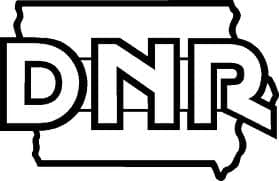Iowa Mussel Blitz
Iowa Department of Natural Resources 08.29.12

Pollywogging is a good name for grubbing through the sand and gravel beds of a stream. Like the young amphibians they imitate, pollywoggers work their way through the water on interior rivers in Iowa. These human-sized creatures, though, are combing the bottom for that bump or marble-like feel of a hidden mussel-or clam. Through the just concluded ‘Mussel Blitz,’ however, the summer’s drought had them often poking through just a couple inches of water.
Iowa’s prairie and woodland creeks and rivers once teemed with mussel beds. They filtered the water as they sought food. That benefited native fish species. They became food themselves. As the European settlement spread across the Midwest, a loss of habitat, primarily from sediment covering their preferred sand and gravel bars, sent mussel populations plummeting.
“Historically, there were maybe 54 species. Now, it’s about 42. Of those, nine are endangered. Another six are threatened. Many more could be added,” lists Scott Gritters, DNR fisheries biologist and Clamming Crew Captain of the mobile survey team.
These days, fisheries workers, county conservation employees, U.S. Fish & Wildlife Service divers and others anticipate live mussels by the dozens instead of by the boatloads. They get excited, too, if a targeted species appears. That means crawling on their hands and knees through late summer streams; usually up to their shoulders, combing promising stretches for the telltale bumps that might be clams.
Most are returned to the water. In some cases, however, a rare find is sent back to the Fish & Wildlife Service lab in Wisconsin, where it can be propagated. Glochidia (tiny, fertilized larvae) are inoculated into the gills of host fish, which are then stocked in areas of good habitat. Eventually, the glochidia fall off and–with luck–grow to be discovered in a few years by prying hands from above.
It’s a waterlogged version of a needle in the haystack.
“We know how to stock fish; where to place them, what works best,” says Gritters, drawing parallels to a science that is over a century old. “With mussels, we are learning as we go. How many do we stock? Where exactly do we place them? To re-introduce-especially endangered mussels-we have a whole lot more testing to do. That’s why we’re here today.”
‘Here’ was a stretch of Mineral Creek, in Jones County. On subsequent days, the crew moved to the Wapsipinicon River, then south to the Skunk River near Brighton. That rotation shifts from year to year, with special attention given to streams that historically harbored rare species, like the Higgins-eye.
As his crew left the bluff-shaded Mineral Creek, results were akin to the old ‘glass half full, half empty’ adage.
“It was certainly a success in that we found some-fat mucket and plain pocketbook mussels–from our stocking four years ago. So we know they can live here,” notes Gritters. “On the downside, we didn’t find a whole lot of them. Did we stock enough? Are raccoons and other predators having a huge impact?”
On the other hand, moving shoulder to shoulder upstream for that quarter mile, the crew found dozens of young cylindrical papershells; a state endangered species. That 2008 survey yielded none. Were they growing now because of water quality work along the stream? Later in the week, the clammers found nine species on the Wapsi (down from 17 last time) but an encouraging 12 on the Skunk…including several ‘monkey face’ and ‘pistolgrips.’ Mussels may be hard to find, but they have great names.
Those variables are plugged in to the growing data bank, as biologists build a foundation to understand mussels and how to increase their numbers; hidden in those winding Iowa streambeds.

